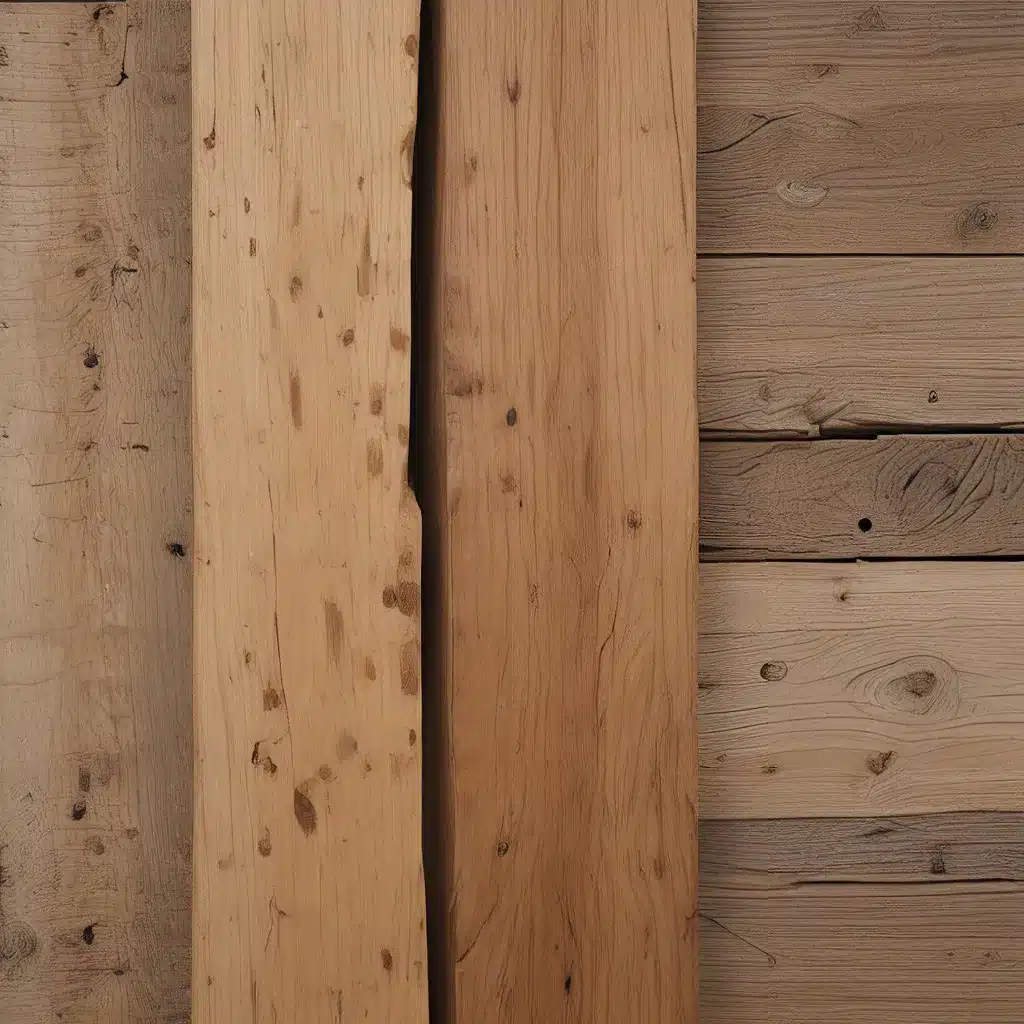
The Enchanting Embrace of Imperfection
Picture this: You walk into a cozy workshop, the air thick with the earthy scent of freshly sanded wood. Your eyes are drawn to a magnificent table, its surface adorned with the natural patterns and gentle undulations of the grain. It’s not flawlessly smooth – in fact, it seems to bear the marks of its creation, like the brushstrokes of a masterful painter. This, my friend, is the essence of wabi-sabi – the Japanese aesthetic that finds profound beauty in imperfection, impermanence, and incompleteness.
As a devotee of the unfinished furniture movement, I’ve long been captivated by this philosophy. It’s a radical departure from the Western obsession with perfection, inviting us to see the world through a lens of elegant simplicity and reverence for the natural order. And nowhere is this more apparent than in the world of traditional woodworking.
Embracing the Unique Characteristics of Wood
Imagine running your fingers along the weathered surface of a piece of reclaimed timber, tracing the knots and cracks that tell the story of its past life. To a wabi-sabi woodworker, these so-called “flaws” are not something to be hidden or eliminated, but rather celebrated as the very essence of the material. Each scar, each quirk of the grain, is a testament to the wood’s journey – a living, breathing record of its interactions with the elements.
This approach stands in stark contrast to the mass-produced, cookie-cutter furniture that has long dominated the market. Instead of striving for uniform perfection, wabi-sabi woodworkers revel in the unique characteristics of each piece of wood, leaving natural edges, integrating cracks as design elements, and using oil finishes that enhance the material’s inherent properties.
The Allure of Simplicity and Minimalism
Wabi-sabi’s embrace of imperfection also manifests in a reverence for simplicity and minimalism. The philosophy encourages stripping away the unnecessary, focusing on what is essential, and allowing the natural beauty of the materials to shine through. This can be seen in the clean, understated lines of wabi-sabi furniture, where the wood itself becomes the star of the show.
One of the most striking examples of this aesthetic can be found in the work of the legendary woodworker and architect, George Nakashima. His iconic Conoid Studio, with its gravity-defying concrete roof, and the Minguren Museum, with its soaring plywood hyperbolic paraboloid, are testaments to his ability to blend traditional Japanese influences with a thoroughly modern sensibility.
The Art of Repair and Transformation
In the wabi-sabi worldview, even the process of repair is considered an art form. Take the Japanese technique of Kintsugi, where broken pottery is mended with gold lacquer, highlighting the repair as an integral part of the object’s history and beauty. A similar approach can be found in woodworking, where techniques like butterfly joinery not only restore damaged pieces, but also elevate their imperfections as key design elements.
This idea of embracing the story behind an object, rather than trying to erase it, is at the heart of the wabi-sabi philosophy. It’s a radical departure from the throwaway culture that has become the norm, encouraging a more mindful and sustainable approach to consumption and production.
A Niche with Growing Appeal
As consumers become increasingly attuned to the value of authenticity and environmental sustainability, the unique appeal of wabi-sabi in woodworking has found a distinct niche in the market. These one-of-a-kind pieces, with their stories and imperfections, are highly sought after by a growing demographic that values craftsmanship and meaning over mass-produced uniformity.
But the appeal of wabi-sabi goes beyond mere aesthetic preferences. It’s a philosophical shift that challenges the very foundations of our modern, industrialized world. By embracing the beauty of imperfection, we’re not just creating beautiful furniture – we’re cultivating a deeper appreciation for the natural world and our place within it.
The Risks and Rewards of Wabi-Sabi Woodworking
Of course, with this embrace of the unconventional comes a unique set of challenges for wabi-sabi woodworkers. The use of unique, sometimes unpredictable materials means that they face specific risks, from property damage to liability claims. That’s why having the right Woodworker Business Insurance is crucial – it can protect their business against unforeseen setbacks and ensure that they can continue to create their masterpieces, even in the face of adversity.
But the rewards of this approach far outweigh the risks. By adopting wabi-sabi principles, woodworkers can significantly reduce waste, maximize the use of materials, and create pieces that are not only functional but also artistically and philosophically meaningful. And for a growing number of consumers, that’s exactly what they’re searching for.
Embracing the Imperfect Journey
As I step back and admire the weathered table in the workshop, I can’t help but wonder about the stories it could tell. The knots and cracks, the gentle undulations of the grain – they’re not flaws to be hidden, but rather the very essence of the wood’s unique character. It’s a profound lesson in the beauty of imperfection, one that has the power to transform the way we see the world around us.
So, the next time you find yourself drawn to a piece of unfinished furniture, take a moment to pause and appreciate the wabi-sabi that lies within. Embrace the imperfect, the impermanent, and the incomplete – for in doing so, you just might discover a deeper connection to the natural world, and a more fulfilling way of living.








